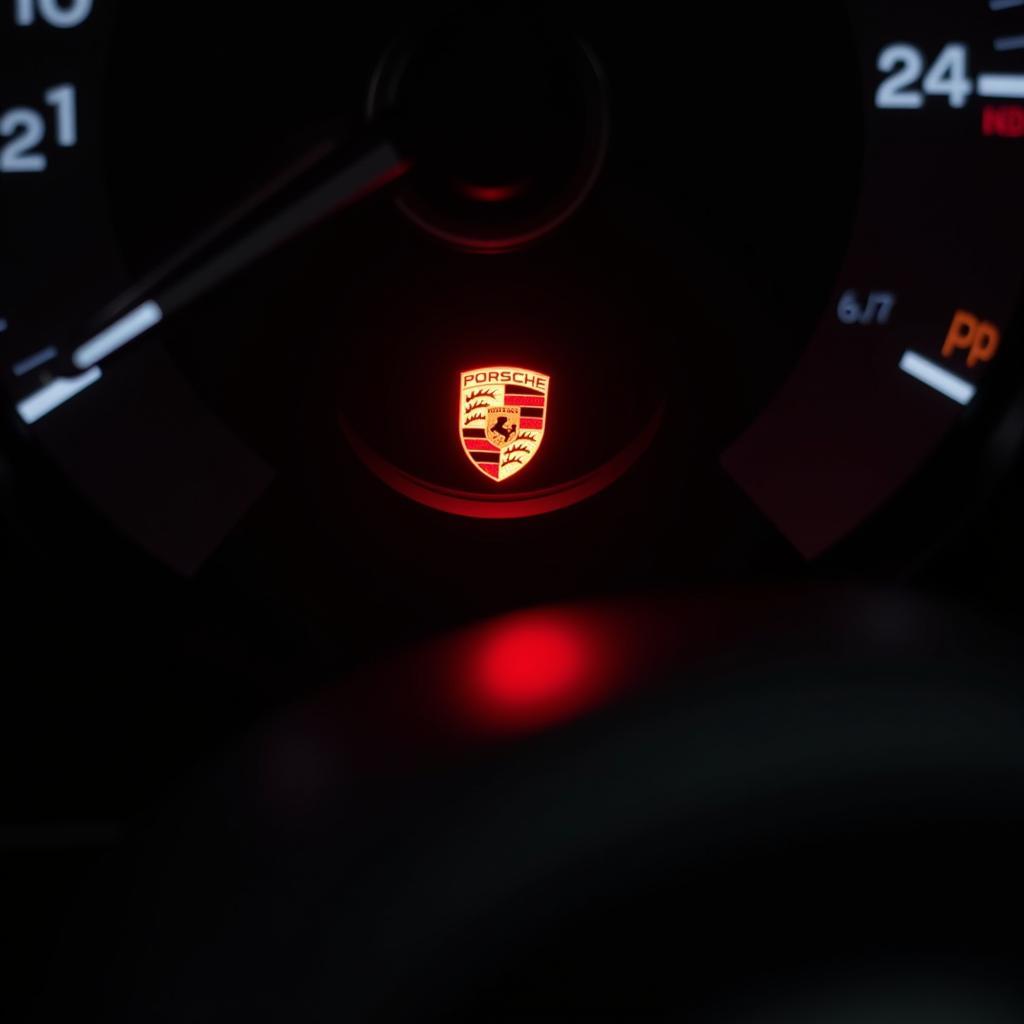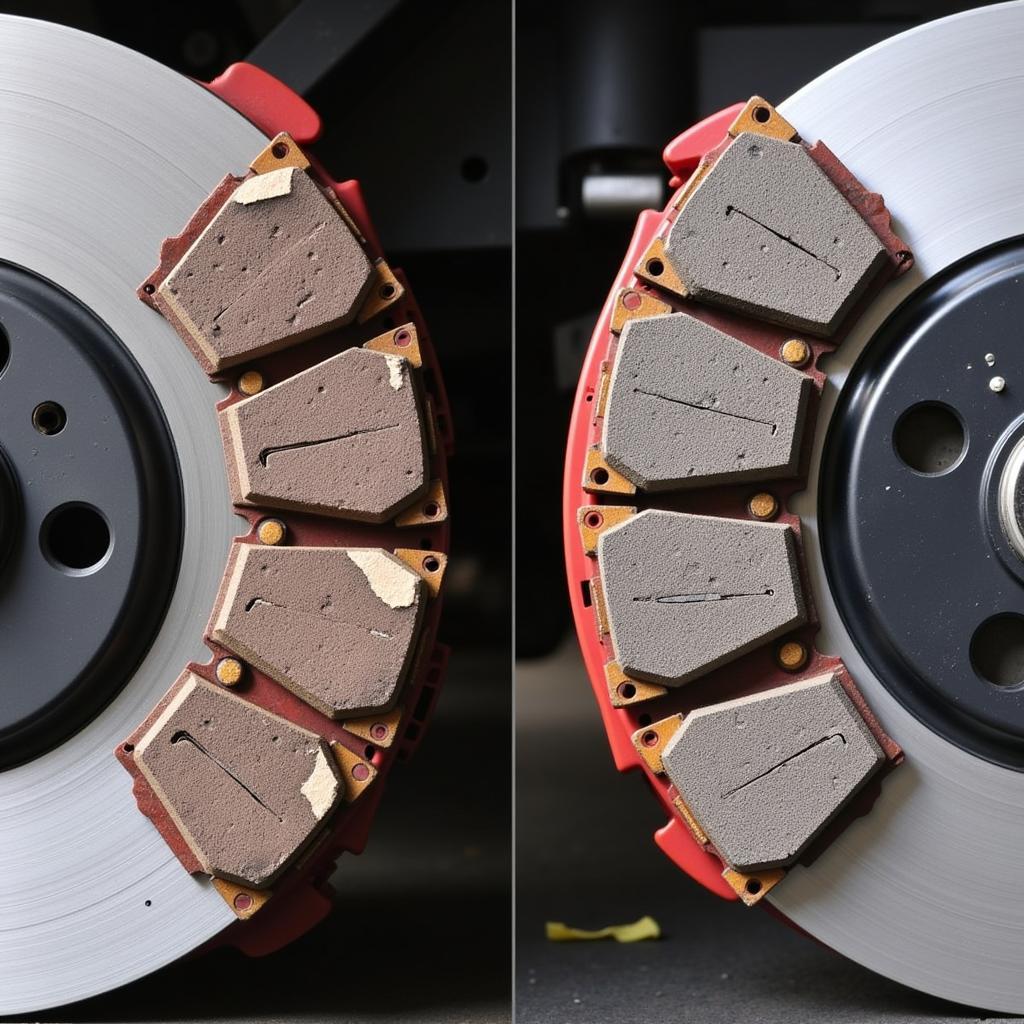The dreaded brake warning light on your Porsche dashboard can be a cause for concern. While it’s designed to alert you of potential braking system issues, deciphering its meaning can be confusing. This comprehensive guide will delve into the common reasons behind a Porsche brake warning light, provide insights into diagnosis, and offer potential solutions.
Understanding Your Porsche’s Brake Warning System
Porsche vehicles are equipped with sophisticated braking systems designed for optimal performance and safety. The brake warning light is a crucial component of this system, serving as an early indicator of potential issues. It can illuminate for various reasons, ranging from low brake fluid levels to more critical problems like a malfunctioning ABS system.
 Porsche Brake Warning Light on Dashboard
Porsche Brake Warning Light on Dashboard
Common Causes of a Porsche Brake Warning Light
Low Brake Fluid
One of the most common culprits is low brake fluid. Brake fluid is the lifeblood of your Porsche’s braking system, transmitting the force from your foot on the brake pedal to the brake calipers, which then squeeze the brake pads against the rotors to slow down or stop the car. Over time, brake fluid can become depleted due to leaks or normal wear and tear.
Worn Brake Pads
Brake pads are designed to wear down over time. When they reach a certain thickness, a sensor triggers the brake warning light. Worn brake pads compromise your Porsche’s braking efficiency and should be replaced immediately.
 Worn Out Porsche Brake Pads
Worn Out Porsche Brake Pads
ABS System Malfunction
Your Porsche’s Anti-lock Braking System (ABS) is crucial for maintaining control during hard braking. If the ABS module detects a problem, it can trigger the brake warning light. This could indicate a faulty sensor, a malfunctioning pump, or other issues within the ABS system.
Brake Caliper Issues
Brake calipers are responsible for clamping the brake pads onto the rotors. A sticking or seized caliper can cause uneven braking, premature pad wear, and potentially trigger the brake warning light.
Parking Brake Engaged
While seemingly obvious, it’s easy to overlook. If the parking brake is even slightly engaged, the brake warning light may remain illuminated.
 Porsche Parking Brake Engaged
Porsche Parking Brake Engaged
What to Do When Your Porsche Brake Warning Light Turns On
“Ignoring a brake warning light can lead to dangerous situations,” warns Mark Schmidt, a seasoned Porsche technician with over 20 years of experience. ” It’s crucial to address the issue promptly to ensure your safety and the optimal performance of your Porsche.”
Here’s a step-by-step guide on what to do:
- Safely park your Porsche. If the light appears while driving, find a safe location to pull over as soon as possible.
- Check the parking brake. Ensure the parking brake is fully disengaged.
- Inspect brake fluid level. Locate the brake fluid reservoir under the hood and check if the fluid level is within the minimum and maximum markers.
- Avoid driving. If the brake fluid is low, or you suspect a more serious issue, avoid driving and contact a qualified Porsche technician immediately.
Diagnosing the Issue
A professional Porsche technician will have the tools and expertise to accurately diagnose the root cause of the brake warning light. They will likely:
- Connect a diagnostic scanner: This retrieves trouble codes stored in your Porsche’s computer, providing valuable insights into the potential cause.
- Inspect brake components: This involves a thorough examination of the brake pads, rotors, calipers, brake lines, and other related components for wear, damage, or leaks.
- Test the ABS system: This may include testing the wheel speed sensors, ABS module, and hydraulic unit.
Remote Software Solutions for Porsche Brake Issues
In some cases, the brake warning light might be triggered due to software glitches or faulty sensor readings. At Car Diag Tech, we offer remote software solutions for various Porsche models. Our expert technicians can access your car’s system remotely, diagnose the problem, and potentially resolve it through software updates or recalibrations, saving you time and potentially costly repairs.
Conclusion
The brake warning light on your Porsche is a critical safety feature. Understanding its potential causes and taking prompt action can prevent accidents and ensure your Porsche continues to deliver a thrilling yet safe driving experience. While simple checks like the parking brake and brake fluid levels can be done at home, it’s essential to seek professional help from a qualified Porsche technician or a specialized service provider like Car Diag Tech for diagnosis and repair.
FAQs about Porsche Brake Warning Lights
Q: Can I drive my Porsche with the brake warning light on?
A: It’s strongly advised against driving your Porsche with the brake warning light illuminated. This could indicate a serious braking system issue that compromises your safety.
Q: How often should I change my Porsche’s brake pads?
A: Brake pad lifespan varies depending on driving style and conditions. However, it’s generally recommended to have them inspected every 10,000 miles and replaced as needed.
Q: How can I prevent brake warning light issues in my Porsche?
A: Regular Porsche maintenance, including brake fluid flushes, brake inspections, and timely replacement of worn components, can significantly reduce the likelihood of brake warning light issues.

